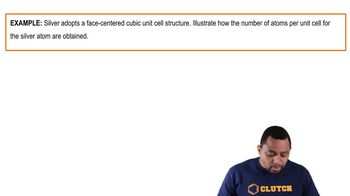Polyacrylonitrile (PAN) is an addition polymer with the struc- ture shown here. Draw the structure of the monomer.
Ch.13 - Solids & Modern Materials

Chapter 13, Problem 82
The density of an unknown metal is 12.3 g/cm3, and its atomic radius is 0.134 nm. It has a face-centered cubic lattice. Find the atomic mass of this metal
 Verified step by step guidance
Verified step by step guidance1
Convert the atomic radius from nanometers to centimeters. Since 1 nm = 1 x 10^{-7} cm, multiply the atomic radius by this conversion factor.
Calculate the volume of the unit cell. For a face-centered cubic (FCC) lattice, the edge length (a) of the unit cell is related to the atomic radius (r) by the formula: a = 2\sqrt{2}r.
Determine the volume of the unit cell using the formula: Volume = a^3, where a is the edge length calculated in the previous step.
Calculate the mass of the unit cell using the density formula: Density = Mass/Volume. Rearrange to find Mass = Density x Volume, using the given density and the volume from the previous step.
In a face-centered cubic lattice, there are 4 atoms per unit cell. Use the mass of the unit cell to find the atomic mass by dividing the mass of the unit cell by the number of atoms per unit cell.

Verified video answer for a similar problem:
This video solution was recommended by our tutors as helpful for the problem above.
Video duration:
3mWas this helpful?
Key Concepts
Here are the essential concepts you must grasp in order to answer the question correctly.
Density and its Calculation
Density is defined as mass per unit volume, typically expressed in grams per cubic centimeter (g/cm³). In this context, the density of the metal is given, which can be used alongside its atomic structure to derive its atomic mass. The formula for density (density = mass/volume) is crucial for solving the problem.
Recommended video:
Guided course

Density Concepts
Face-Centered Cubic (FCC) Structure
A face-centered cubic lattice is a type of crystal structure where atoms are located at each corner and the centers of all the cube faces. This arrangement affects the packing efficiency and the volume occupied by the atoms. Understanding the FCC structure is essential for calculating the volume of the unit cell, which is necessary for determining the atomic mass from the given density.
Recommended video:
Guided course

Face Centered Cubic Example
Atomic Mass and Molar Volume Relationship
The atomic mass of a substance can be related to its density and the volume of its unit cell. For an FCC structure, the volume of the unit cell can be calculated using the atomic radius, and the number of atoms per unit cell (4 for FCC) allows for the calculation of atomic mass using the formula: atomic mass = (density × molar volume). This relationship is key to solving the problem.
Recommended video:
Guided course

Molar Mass Concept
Related Practice
Textbook Question
Textbook Question
Copper iodide crystallizes in the zinc blende structure. The sep- aration between nearest neighbor cations and anions is approximately 311 pm, and the melting point is 606 °C. Potassium chloride, by contrast, crystallizes in the rock salt structure. Even though the separation between nearest-neighbor cations and anions is greater (319 pm), the melting point of potassium chlo- ride is higher (776 °C). Explain.
Textbook Question
An unknown metal is found to have a density of 7.8748 g/cm3 and to crystallize in a body-centered cubic lattice. The edge of the unit cell is 0.28664 nm. Calculate the atomic mass of the metal.
1
views
Textbook Question
Calculate the fraction of empty space in cubic closest packing to five significant figures.
